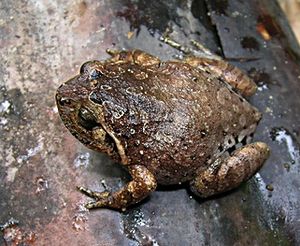Plethodontohyla alluaudi
| Plethodontohyla alluaudi | ||||||||||||
|---|---|---|---|---|---|---|---|---|---|---|---|---|

Plethodontohyla alluaudi |
||||||||||||
| Systematics | ||||||||||||
|
||||||||||||
| Scientific name | ||||||||||||
| Plethodontohyla alluaudi | ||||||||||||
| ( Mocquard , 1901 ) |
Plethodontohyla alluaudi ( synonym : Rhombophryne alluaudi ) is a frog from the family of narrow-mouthed frogs (Microhylidae)livingon the island of Madagascar .
features
The head-torso length of Plethodontohyla alluaudi is 30 to 60 millimeters, the legs are short and show some whitish spots on the inside of the hind legs. The second and fourth toes are roughly the same length. The skin on the back is either smooth or slightly grainy. The back has a brownish color against which an irregular pattern stands out. The flanks are marbled brown with whitish spots. The underside is yellowish and shows peach-colored spots in the front area and a slightly pinkish tint in the rear area.
The head is much wider than it is long, almost as wide as the body. The snout appears rounded both when viewed from above and when viewed from the side. A bright supratympanic fold extends from behind the eye to the shoulder or the deflection of the arms. On the back of the head, a wide x-shaped spot extends into the nape of the neck. The throat of the males is dark in color. You have throaty vocal sacs.
Similar species
The similar species Rhombophryne laevipes differs through the longer hind legs. In Pletodontohyla laevis , the whitish spots on the extremities are absent and the tympanum is smaller.
distribution and habitat
Plethodontohyla alluaudi is endemic to the east and southeast of Madagascar . The frog comes lives in the intact forests of various protected areas, but its range is fragmented and continues to lose size due to logging. The species was detected at altitudes between sea level and 230 meters.
Way of life
Because of its short legs, which are well suited for digging, the species prefers to stay in moist recesses on the forest floor under rotting wood or under leaves. The male vocalizations, which consist of individual tones with fairly long intervals, are also emitted from such burrows. Further detailed knowledge about special behavior as well as the reproduction of the species is currently not available.
Systematics and taxonomy
In 1901 as Dyscophus alluaudi by François Mocquard for the first time , the species was finally placed in 2006 as Rhombophryne alluaudi in the genus Rhombophryne . After a revision in 2018, it came into the genus Plethodontohyla . In the same revision, Plethodontohyla laevis was re-established as a separate species, having been regarded as a synonym of Plethodontohyla alluaudi since 1991 .
Danger
For Rhombophryne alluaudi a relatively large distribution area in the east of Madagascar was assumed and the species was classified as " least concern" by the World Conservation Organization IUCN . After the new description in 2018 it became clear that Plethodontohyla alluaudi and Plethodontohyla laevis are different species, each of which has an increasingly fragmented and shrinking range and which are therefore to be classified as endangered.
Individual evidence
- ↑ a b c d e f A. Bellati, MD Scherz, S. Megson, SH Roberts, F. Andreone, GM Rosa, J. Noël, JE Randrianirina, M. Fasola, F. Glaw, and A. Crottini: Resurrection and re-description of Plethodontohyla laevis (Boettger, 1913) and transfer of Rhombophryne alluaudi (Mocquard, 1901) to the genus Plethodontohyla (Amphibia, Microhylidae, Cophylinae). Zoosystematics and Evolution, 94, pp. 109-135, 2018.
- ↑ a b c Frank Glaw , Miguel Vences : Field Guide to the Amphibians and Reptiles of Madagascar , Vences and Glaw Verlag, Cologne, 2007, ISBN 978-3-929449-03-7
- ^ IUCN Red List
literature
- François Mocquard: Note préliminaire sur une collection de reptiles et de batraciens recueillis par M. Alluaud dans le sud de Madagascar. Bulletin du Muséum national d'histoire naturelle, Vol. 7, pp. 251–256, 1901 (first description, digitized , French)
- Angel: Matériaux herpétologiques recueillis à Madagascar par M. Roger Heim, chargé de Mission. Description of two new forms . Bulletin du Muséum National d'Histoire Naturelle, Ser. 2, 8, pp. 125-129, 1936
- Oscar Böttger: Reptiles and amphibians from Madagascar, the islands and the mainland of East Africa . In: Voeltzkow: Journey in East Africa in the years 1903–1905 with funds from Hermann and Elise geb. Heckmann Wentzel Foundation. Scientific results. Systematic work. 3, 4, pp. 269-376, 1913. ( Scan , German).